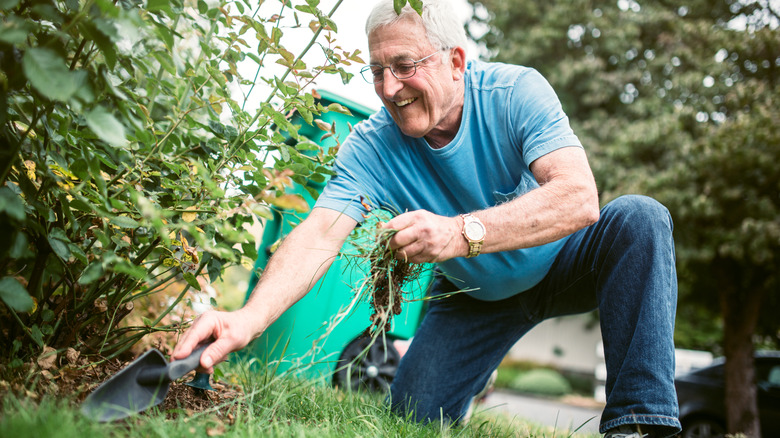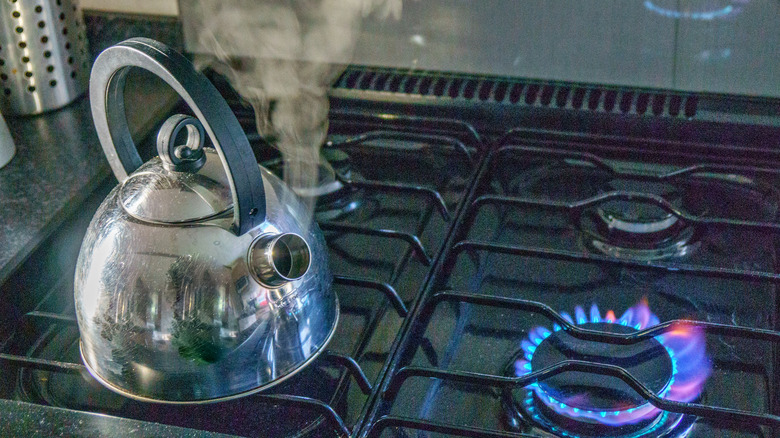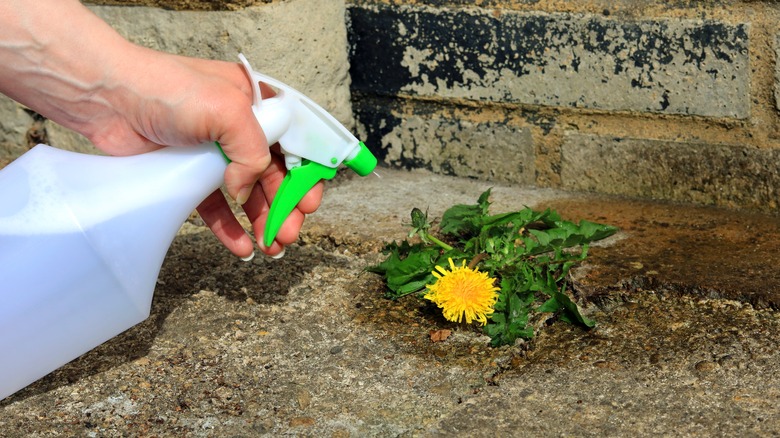Why You Should Try Using Boiling Water To Kill Your Lawns Weeds
Forget about chugging sports drinks, tropical libations, or multicolored smoothies following a long day of yard work. Instead, consider prepping some hot water for you — and your weeds. Killing pesky unwanted plants by dousing them with boiling water is a landscaping hack that goes back centuries. Today, the practice is embraced by homeowners looking for a chemical-free weed eliminator that is safe for humans, pets, and the environment.
Remember the scene in "The Wizard of Oz" when Dorothy threw water on the Wicked Witch of the West? The green-faced sorceress shriveled up and died. A very similar reaction occurs when you pour boiling water on weeds. As scalding water comes into contact with weeds, it instantly melts the plants' protective waxy cuticle and destroys their anatomical structure in a dramatic fashion. Moreover, unlike chemical pesticides which vaporize, go airborne, and can cause harm to humans and neighboring plants, hot water inherently flows downward. This allows for direct contact with common garden weeds, whether they are growing along sidewalks, in between pavers, or under decks. What's more, the concentrated impact of hot water on a patch of weeds creates added structure-crushing pressure that traditional herbicides don't offer.
How to kill weeds with boiling water
If you are wondering how to get rid of weeds in your garden using hot water, start by grabbing a tea kettle and firing up the stove. Water boils at 212 degrees Fahrenheit which is strong enough to terminate young and mature weeds. Once the kettle's whistle blows, pull on an oven mitt or protective gloves before venturing outside to soak your weeds. If you are using a large pot or pan to boil water, it is critical to place a lid on the vessel prior to moving it outside. Covering the boiling water will not only help retain its heat, but it also prevents the scorching liquid from splashing out and burning exposed skin. To avoid injuries, consider wearing long sleeves, long pants, and closed-toe shoes.
Before dumping boiling water on weeds, bend or kneel down to get as close to your target as possible. Aim directly for the unwanted plants. You want to be precise with your pouring so as to not damage any prized plants that may be in close proximity to their invasive counterparts. Next, flood the weeds with copious amounts of boiling water. You should see the weeds wilt instantaneously. As the hot water seeps into the soil, the extreme heat will dehydrate the weed's root system. It's a good idea to give the boiling water a few minutes to thoroughly seep into the ground before fully eradicating the weeds. Doing so allows the water to cool so you don't suffer burns when removing what remains of the weed.
Pros and cons of using boiling water as a pesticide
On average, a gallon of commercial pesticide runs about $20. Compare that with tap water that costs less than a penny a gallon (per American Water Works Association), and it's no surprise many homeowners try using boiling water to kill weeds. What's more, you can continue to stretch your dollar by using the leftover hot weed water to sterilize potting soil. Saturating potting soil with hot water prior to planting seeds helps kill bacteria and viruses that inhibit healthy germination. If you are extra frugal, you can even recycle an empty pesticide spray bottle by filling it with boiling water.
Naturally, not all gardeners embrace hot water as a weapon in the war against unsightly weeds. Some critics question the effectiveness of hot water against stubborn weeds like dandelions with long taproots. In this case, a singular application of boiling water is likely a temporary fix, while a complete extermination calls for repeated drenching that you may find time-consuming and slightly labor-intensive. A more efficient option is to shear off the tops of weeds with prickly or creeping stems and hit the fibrous roots directly with an aggressive shot of boiling water.


